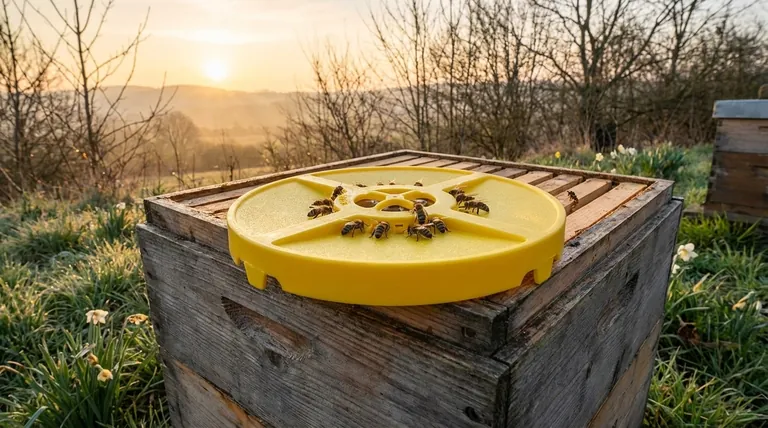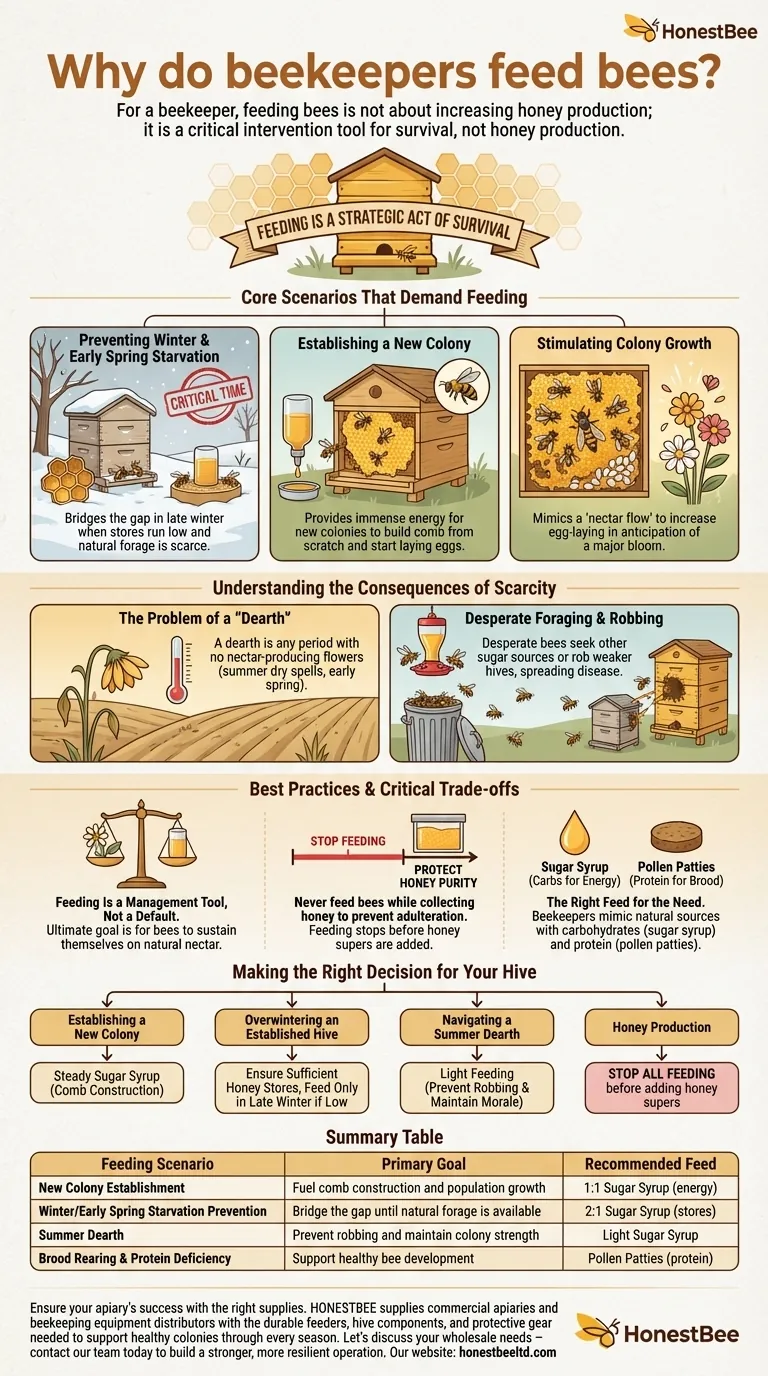For a beekeeper, feeding bees is not about increasing honey production; it is a critical intervention tool. Beekeepers feed bees for two primary reasons: to prevent the colony from starving when natural food sources are scarce, and to provide new colonies with the immense energy required to build their hive from scratch.
The core principle is simple: feeding is a strategic act of survival, not a method for producing honey. It's a last resort used to support a colony through periods of establishment, seasonal gaps, or environmental stress, ensuring its long-term health and stability.

Core Scenarios That Demand Feeding
A responsible beekeeper constantly monitors their hives and the surrounding environment to determine if intervention is necessary. Feeding is typically reserved for a few specific, high-stakes situations.
Preventing Winter and Early Spring Starvation
The most critical time for a beehive is late winter through early spring. The colony has consumed most of its stored honey to survive the cold, but the first flowers of the season have not yet bloomed.
This creates a dangerous gap where a colony, full of bees and developing brood, can run out of food and starve just weeks before nature begins providing again. Supplemental feeding bridges this crucial period.
Establishing a New Colony
When a beekeeper starts a new hive, the bees arrive with nothing. They have no drawn honeycomb, no stored honey, and no pollen reserves.
Worker bees must consume huge amounts of energy to produce wax and build out the comb. Feeding them sugar syrup provides the essential fuel for this massive construction project, allowing the queen to begin laying eggs and the colony to establish itself.
Stimulating Colony Growth
Sometimes, a beekeeper will feed a light sugar syrup to mimic a natural "nectar flow." This signals to the queen that resources are abundant.
In response, she will increase her egg-laying rate. This technique helps build up the hive's population in anticipation of a major bloom, ensuring a maximum number of forager bees are ready to collect nectar when it becomes available.
Understanding the Consequences of Scarcity
If bees cannot find adequate natural food sources and a beekeeper doesn't intervene, the colony's survival instincts can create problems for both the bees and their neighbors.
The Problem of a "Dearth"
A "dearth" is any period when there are no significant nectar-producing flowers in bloom. This can happen during a dry spell in summer just as easily as it can in early spring.
Desperate Foraging and Robbing
During a dearth, bees become desperate. They will abandon flowers and seek out other sugar sources, including hummingbird feeders, garbage cans, and discarded soda cans.
More dangerously, strong hives may attempt to "rob" honey from weaker neighboring hives. This behavior can quickly decimate the weaker colony and spread diseases between hives. Feeding can reduce the desperation that leads to robbing.
Best Practices and Critical Trade-offs
Feeding is a powerful tool, but it must be used responsibly to maintain the health of the colony and the integrity of the honey.
Feeding Is a Management Tool, Not a Default
The ultimate goal is for bees to sustain themselves on natural nectar and pollen. Feeding is an intervention for when nature falls short. It is not a replacement for a healthy environment.
Protecting Honey Purity is Paramount
Beekeepers who produce honey for human consumption never feed bees while collecting honey. Any sugar syrup stored by the bees would adulterate the final product, which would no longer be pure honey.
All feeding is stopped well before the "honey supers"—the boxes used for honey collection—are placed on the hive.
The Right Feed for the Need
Bees require two types of food: carbohydrates and protein. Beekeepers mimic these with different feeds.
Sugar syrup (sugar and water) is fed as a substitute for honey, providing carbohydrates for energy. Pollen patties (a mix of proteins) are used when there is a lack of natural pollen, which is essential for raising young bees.
Making the Right Decision for Your Hive
Your decision to feed should always be based on the specific condition of your colony and the availability of natural forage.
- If your primary focus is establishing a new colony: You must provide a steady supply of sugar syrup to fuel the critical process of comb construction.
- If your primary focus is overwintering an established hive: Ensure your bees have sufficient honey stores in the fall; only feed in late winter if their stores are dangerously low.
- If your primary focus is navigating a summer dearth: A light feeding can prevent robbing and maintain colony morale until the next major bloom.
- If your primary focus is honey production: You must stop all feeding before adding honey supers to ensure your final product is pure, natural honey.
Ultimately, feeding is a beekeeper's most direct tool for balancing the needs of a colony with the realities of the environment.
Summary Table:
| Feeding Scenario | Primary Goal | Recommended Feed |
|---|---|---|
| New Colony Establishment | Fuel comb construction and population growth | 1:1 Sugar Syrup (energy) |
| Winter/Early Spring Starvation Prevention | Bridge the gap until natural forage is available | 2:1 Sugar Syrup (stores) |
| Summer Dearth | Prevent robbing and maintain colony strength | Light Sugar Syrup |
| Brood Rearing & Protein Deficiency | Support healthy bee development | Pollen Patties (protein) |
Ensure your apiary's success with the right supplies. Feeding is a critical management tool, and having reliable, high-quality equipment is just as important. HONESTBEE supplies commercial apiaries and beekeeping equipment distributors with the durable feeders, hive components, and protective gear needed to support healthy colonies through every season. Let's discuss your wholesale needs – contact our team today to build a stronger, more resilient operation.
Visual Guide

Related Products
- Professional Hive Top Bee Feeder for Beekeeping
- Rapid Bee Feeder White Plastic 2L Round Top Feeder for 8 or 10-Frame Bee Hives
- HONESTBEE Round Hive Top Bee Feeder for Syrup
- HONESTBEE Entrance Bee Feeder Professional Hive Nutrition Solution for Beekeeping
- Professional Hive Front Entrance Bee Feeder
People Also Ask
- Do I need an inner cover with a hive top feeder? Optimize Your Hive Setup for Healthy Bees
- What are the features of top feeders for bees? Maximize Hive Health with Safe, High-Capacity Feeding
- What is a top feeder for bees? Maximize Colony Health with Efficient Feeding
- What is the best bee feeder for a hive? Choose the Right Feeder for Your Apiary's Scale
- How to use a top feeder in a beehive? A Guide to Effective Beehive Feeding



















